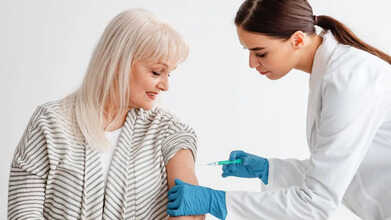- Health Conditions A-Z
- Health & Wellness
- Nutrition
- Fitness
- Health News
- Ayurveda
- Videos
- Medicine A-Z
- Parenting
World Down Syndrome Day: Why The First 5 Years Matter For Kids With Down Syndrome?

Image Credits: Canva
During my time as a special educator, I encountered numerous children who required care, affection, and early intervention. Some were from poor families where even basic medical care and developmental guidance were lacking. I still recall a young boy who could not walk because his muscle tone was low—his parents, not knowing about the advantages of early therapy, could not afford it. There was another child with major speech delays because he had untreated hearing problems. These are early years, and they are pivotal, but so many kids blew past the window of care and had life-altering physical and cognitive setbacks.
Down Syndrome (DS) is a genetic disorder that impacts people differently, affecting their physical, intellectual, and emotional growth. Early childhood, especially the first five years, is an important time for children with DS because it lays the groundwork for their health, mobility, learning, and socialization in the future. This article discusses why the early years are important and how focused interventions can make a big difference in the quality of life for children with Down Syndrome.
Down Syndrome results from a complete or partial extra copy of chromosome 21, causing variations in physical traits, muscle tone, mental ability, and medical conditions. Each of the three forms of DS—Trisomy 21 (95%), Translocation (3%-4%), and Mosaicism (1%)—involves different levels of delays in development and medical issues. People with DS tend to experience increased loss of mobility and secondary medical problems over time, so early intervention becomes imperative.
Down Syndrome (DS) is a genetic disorder resulting from the presence of an extra copy of chromosome 21. Although developmental delay is evident in children with DS, intervention during early stages can significantly influence their development, health, and quality of life. The most critical years are the first five years because these form the bases of cognitive, motor, and social development.
The First Five Years of Development
Year 1: Sensory and Motor Skill Development
During their initial year, babies with DS also have low muscle tone (hypotonia) that can put back motor developmental milestones such as holding their heads up, turning over, and sitting without help. Physical therapy early on in life improves muscle strength and coordination. Sensory stimulation, touch, and listening are very much necessary in ensuring that they engage with the surroundings. Frequent medical checkups to keep up with heart ailment and eating difficulties are extremely important.
Year 2: Improving Motor and Communication Skills
Most toddlers with DS by age two begin crawling and pulling to stand. Walking, though, might still be delayed because of balance problems. Speech development is also initiated, but expressive language development could be slower. Speech therapy is crucial in enabling them to communicate well. Facilitating social interaction through play could enhance cognitive and emotional development.
Year 3: Achieving Independence in Daily Activities
By age three, DS children usually begin to walk, but with a broad gait. They start to refine motor skills such as holding tiny objects and eating with utensils. Programs of early childhood education incorporating interactive learning and play structured to stimulate problem-solving skills and social interaction assist them in gaining these skills. Occupational therapy may aid in the development of self-help skills such as dressing and feeding.
Year 4: Enlarging Social and Emotional Competencies
Four-year-olds with DS develop greater independence and emotional sensitivity. They begin to learn about routines and are able to follow simple commands. Yet, they continue to have difficulty with attention and impulse control. Structured preschool programs offer critical cognitive stimulation, while therapy helps increase attention span and flexibility within the group. Peer interaction, encouraged by matching and group activities, promotes social skills.
Year 5: Preparation for School and Long-Term Progress
By age five, children with DS are ready for structured learning environments. They may have stronger receptive language skills than expressive language, meaning they understand more than they can verbally express. Early reading programs, speech therapy, and individualized education plans (IEPs) help prepare them for mainstream or specialized schooling. Strengthening motor coordination through activities like climbing and drawing enhances both academic readiness and physical independence.
Why Early Intervention Matters for Kids with Down Syndrome?
The first five years set the tone for a child's future development. Early intervention therapies—physical, speech, and occupational—reduce delays and facilitate skill development. Routine medical surveillance ensures the prompt management of frequent health issues like heart disease, thyroid disease, and vision or hearing loss. Moreover, an inclusive and supportive environment allows children with DS to gain confidence and autonomy.
What Role Do Parents Play In Early Care And Support?
Parents are the biggest champions of their child's health. Educating families about DS, giving them emotional support, and introducing them to services like support groups and therapy centers can go a long way in the progress of a child.
Community programs, inclusive schools, and public awareness campaigns reduce stigma and provide an enabling environment where children with DS can grow and develop. Facilitating acceptance and offering customized learning opportunities enable children with DS to join mainstream society confidently.
The first five years of a child's life form the foundation of their overall growth and success. For children with Down Syndrome, these five years are particularly crucial in treating developmental delays, building motor skills, managing health issues, and developing emotional well-being. Through prompt interventions, family support, and exposure to quality healthcare and education, children with DS can lead meaningful lives and reach their full potential.
Flu Symptoms 2025: NHS Warns People With Certain Conditions Face Higher Risk

Credits: Canva
People living with long-term health conditions are among those being urged by the NHS to take a key step as concerns around flu continue to grow. Hospital admissions linked to influenza reached 3,140 by the end of last week, marking the highest level ever recorded for this point in the season and an 18% rise compared to the previous seven days.
NHS Urges People With Long-Term Conditions To Take Action Amid Flu Concerns
Sharing an update on X this afternoon, the NHS said: “Flu can be serious for those at high risk, including children, older adults and people with long-term conditions. 18 million people have had the free NHS flu vaccine, and it’s not too late to get protected. Book via your GP, pharmacy or the NHS App.”
Flu Vaccine Eligibility: Why Flu Vaccination Matters
Flu vaccines are designed to protect against influenza, which can be dangerous and, in some cases, life-threatening for certain groups. Each autumn or early winter, the NHS rolls out these vaccinations for people who are more likely to develop serious complications if they catch the virus.
Flu Vaccine Eligibility: Who Was Eligible From September 1?
Based on guidance from the UK Health Security Agency (UKHSA), six main groups became eligible for the flu vaccine from September 1 this year, with another six groups added from October 1.
From September 1, eligibility included:
- Pregnant women
- All children aged two or three years old on August 31, 2025
- Children with specific long-term health conditions, aged six months to under 18 years
- Primary school children, from reception through Year 6
- Secondary school children, from Year 7 to Year 11
- All children in clinical risk groups aged six months to under 18 years
Flu Vaccine Eligibility: Who became eligible from October 1, 2025?
From October 1, 2025, the following groups were also eligible:
- Everyone aged 65 and over
- Adults aged 18 to 65 with long-term health conditions
- Care home residents
- Carers receiving Carer’s Allowance, or those caring for an elderly or disabled person
- People living with someone who is immunocompromised
- Frontline health and social care workers
How And Where To Get Vaccinated?
The NHS App can be used to check vaccination eligibility. Flu jabs are available through GP practices, selected pharmacies, maternity services, and care homes.
The NHS also notes that health and social care workers may be offered the vaccine at their place of work. Flu vaccinations can be given at the same time as other jabs, including COVID-19 and shingles vaccines.
Commenting on the recent rise in cases, NHS National Medical Director Professor Meghana Pandit said yesterday: “While some parts of the country will be breathing a sigh of relief with flu cases not rising as quickly as feared, we are nowhere near out of the woods yet.
“Combined with the impact of strikes, a stream of winter viruses means many hospitals will be on high alert in the days ahead. But it remains vital that people continue to come forward for NHS care as normal.
“If you need urgent help, dial 999 in an emergency, or use NHS 111 for other care needs. And if you are eligible, please come forward for a jab, it’s not too late.”
Government Appeals To The Public
Health and Social Care Secretary Wes Streeting also addressed the situation, saying: “Flu continues to put significant strain on the NHS, with record numbers of patients in hospital, and frontline services remaining under enormous pressure. I’m appealing to the public to protect yourself and your loved ones by getting your flu jab.
“I want to thank NHS staff who are going above and beyond at the toughest time of year. Thanks to their hard work and careful planning, ambulance handovers are around eight minutes quicker than this time last year.”
Fact Check: Top 5 Flu Vaccine Myths In 2025, Busted

Credits: iStock
Is 2025 the year of Flu? This is the right question to ask as we see so many cases of flu from around the world, worst hit countries remain UK, US, and Canada. The hospitalization rates have gone up. In fact Dr Wenqing Zhang, Unit Head for Global Respiratory Threats at the Department of Epidemic and Pandemic Threats Management of the World Health Organization said that this year is marked by "the emergence and rapid expansion of a new AH3N2 virus subclade". This new variant is called J.2.4.1 or subclade K. This was first reported in August in Australia and New Zealand and has since been detected in over 30 countries.
Amid this there are many myths that surrounds the flu vaccine, on whether it should be administered and if one can get a flu despite getting the jab. Health and Me breaks those myths for you.
The biggest misconception that surround the vaccine right now is its effectiveness, since it has been updated before the new strain or the subclade K/ super flu hit the population. However, Professor Antonia Ho, Professor and Honorary Consultant in Infectious Diseases at the University of Glasgow says, "The vaccine remains the most effective means to prevent disease. We still want to encourage people to get the vaccine."
When a new variant emerges, the flu shot can still offer what doctors call cross-protection. In simple terms, the antibodies your body makes after vaccination can recognize similar flu viruses and respond to them.
Also Read: 186 H3N2 Outbreaks As Hospitalization Rates Double On Canada
Here are the top 5 flu vaccine myths in 2025
Myth 1: Influenza is not serious, so I don’t need the vaccine
Fact: Flu is far from harmless. Each year, up to 650,000 people worldwide die from flu-related respiratory complications. Even healthy individuals can fall seriously ill. In some cases, flu can lead to pneumonia, sinus or ear infections, and inflammation of the heart or brain, especially in those with weaker immunity.
Myth 2: The flu vaccine can give me the flu
Fact: The flu shot uses an inactivated virus, which means it cannot cause influenza. Some people may feel mild fever, body aches, or tiredness after vaccination. These symptoms are short-lived and are simply signs that the immune system is responding.
Myth 3: The flu vaccine causes severe side effects
Fact: Flu vaccines have a strong safety record. Serious side effects are extremely rare. Guillain-Barré Syndrome, a condition linked to muscle weakness and paralysis, occurs in about one in a million vaccinated people, making the risk very low.
Myth 4: I took the vaccine and still got the flu, so it doesn’t work
Fact: Many flu viruses circulate each season, and vaccines target the most common ones. While vaccination may not prevent every infection, it greatly reduces the risk of severe illness and complications. It also helps protect people with vulnerable immune systems.
Myth 5: I am pregnant, so I should not get the flu vaccine
Fact: Pregnant women are strongly advised to get vaccinated because pregnancy weakens the immune system. The inactivated flu vaccine is safe at any stage of pregnancy and helps protect both the mother and the baby.
Will The Old Flu Vaccine Protect You Against The New Subclade K?

Credits: iStock
While H3N2 flu cases are surging, one question that is being asked time and again is whether the old vaccines provide protection against this new variant. While the new strain of virus was detected after the vaccine had already undergone its update, the good news is that it still provides the best protection against the illness from H3N2 strains.
The real reason why concerns are prompted about the effectiveness of the seasonal vaccine is because the virus underwent more mutation than scientists expected over summers. This mutant is called the 'subclade K' or 'super flu'. While it is true that most cases this season are of the 'super flu' strain, experts say that the flu jab is still offering a strong protection.
How Effective Is The Flu Jab Against The New Flu Strain?
"The vaccine remains the most effective means to prevent disease. We still want to encourage people to get the vaccine," said Professor Antonia Ho, Professor and Honorary Consultant in Infectious Diseases at the University of Glasgow. Experts have stressed enough on the immunity that one can receive from the vaccine that that these flu jab remain the best defense against the flu, even though the current strain circulated may have drifted away from the strain included in this year's jab.
Data from the UK Health Security Agency (UKHSA) also show that vaccines is performing as expect, despite the emergence of subclade K.
How Is The Flu Jab Developed?
Every year, experts from the World Health Organization, the Centers for Disease Control and Prevention, and other global health agencies closely track flu trends around the world. They study which strains are spreading and use that data to predict which ones are most likely to dominate the upcoming flu season. The annual flu vaccine is then designed to protect against three or four of those strains.
It’s also worth understanding that more than one influenza A strain usually circulates at the same time. So even if the vaccine is not an exact match for a newer H3N2 strain, it still protects against other common flu viruses, which matters, notes Stony Brook Medicine.
When a new variant emerges, the flu shot can still offer what doctors call cross-protection. In simple terms, the antibodies your body makes after vaccination can recognize similar flu viruses and respond to them. You might still get sick, but the vaccine greatly lowers the chances of severe illness, hospitalization, or worse.
The vaccine offers protection against both types of influenza, including A and B.
Also Read: The New Flu Strain Emerged Too Late For Vaccines, And It Is Already Causing Outbreaks
Is There Any Difference Between Influenza A and B?
Influenza A
Influenza A changes quickly. Its genetic makeup shifts often, which is why new strains keep emerging and why it can trigger large outbreaks. It usually shows up early in the flu season and has been responsible for every major flu pandemic recorded so far.
Influenza B
Influenza B is more stable and does not change as rapidly from year to year. It tends to appear later in the season, often peaking in late winter or spring. While it does not cause pandemics, it can still lead to serious illness, particularly in children and young adults.
© 2024 Bennett, Coleman & Company Limited

